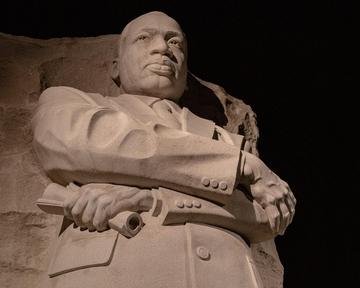Quiz Answer Key and Fun Facts
1. Under the segregation laws, the city buses reserved the front rows for white riders, with the backs of the buses available to the community's African-Americans. On this particular day, Rosa Parks, a seamstress, was seated in the first row behind the whites-only section. How many people were asked to move so that a single white person could take a seat in that row?
2. Parks was arrested and she appealed the decision, challenging the very basis of segregation. In the meantime, a bus boycott was organized. This would have a significant impact of the local bus system since 75% of the ridership was Black. In which city did this boycott take place?
3. An organization of activists and ministers was established to organize the boycott, and these local leaders called upon special young man to lead the group. Who was this man, who was fairly new to town, who had only lived in the town for just over a year at the time?
4. The segregation customs and laws were commonly referred to as the "Jim Crow" laws. These began around the time of Reconstruction (following the Civil War) and continued through the 1950s. Who is Jim Crow believed to have been?
5. Jim Crow laws affected the way of life for African-Americans in every possible way, including education, medical care, and even water fountains and lunch counters. Why do you suppose the bus systems were often the focal point of racial unrest?
6. Parks' case was so significant because she was the first African-American to refuse to give up her seat on a Montgomery bus and be subsequently arrested.
7. This was not the end of the legal troubles that Rosa Parks had to endure. She was indicted again for another crime on February 21, 1956. For what was she arrested?
8. Rosa Parks did not stop with the trials and tribulations surrounding the famous bus ride. She remains active in the civil rights movement and attended the 1963 March on Washington, the Selma-Montgomery March in 1965, and spoke to the Million Man March in 1995 in Washington DC. She also worked in the offices of U.S. Rep John Conyers (D-Michigan) from 1965-1988. Which of these awards did she not receive?
9. The bus on which Parks' rode when she was arrested was retired from service and sold. Later it was used for lumber storage and put out in a field. When it was eventually sold, there was a need to authenticate it as the bus that transported Parks. How was that done?
10. The bus is on display at the Henry Ford Museum. Its restoration cost about $300,000, of which two-thirds was covered by a "Save America's Treasures" grant from the federal government. The bus is a Ford product.
Source: Author
woofi
This quiz was reviewed by FunTrivia editor
bloomsby before going online.
Any errors found in FunTrivia content are routinely corrected through our feedback system.

